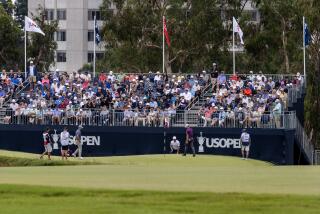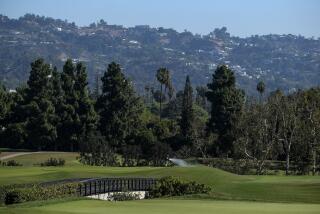Over Hill and ‘Dale
- Share via
Royal Birkdale in Southport, England, designed by George Lowe opened in 1889. In 1932, it was redesigned by Fred Hawtree and five-time British Open champion J.H. Taylor. All 18 greens were redone after the 1991 Open, and several trees and brush have been cleared from the sand dunes.
No. 1, 449 yards, par four: A difficult opening hole. The drive must be placed between out of bounds right and a mound to the left with a bunker in the face it known as “Jutland.” With a good drive, the flag can be seen over an intervening mound on the right. Third-toughest hole at the 1991 Open.
No. 2, 421 yards, par four: This plays into the prevailing wind, with most of the trouble left. Picturesque approach into a tight green surrounded by bunkers and rough banks.
No. 3, 407 yards, par four: The easiest hole in 1991 and the first good chance for birdie. A tee shot down the left side flirts with very heavy rough, but also give an open approach to a low, flat green.
No. 4, 203 yards, par three: The only par three over 200 yards. Slightly elevated green makes club selection and wind judgment critical. Bunkers left and right guard the front of the green.
No. 5, 344 yards, par four: Fairway moves left to right off the tee, with deep rough on both sides. Seven bunkers surround a severely sloped green. An approach that goes over the green could spell disaster.
No. 6, 480 yards, par four: Two fairway bunkers on this long par four. The green has been lengthened since the last Open and requires careful study of pace. Toughest hole in 1991, yielding just 18 birdies.
No. 7, 177 yards, par three: Plays into the prevailing wind and is 20 yards longer than it was in 1991. Green is a small target surrounded by bunkers.
No. 8, 457 yards, par four: A classic links driving hole from an elevated tee to a fairway that curves to the left, favoring a draw to provide an open angle to the green. Four fairway bunkers must be avoided. The contoured green is above the fairway.
No. 9, 411 yards, par four: A blind tee shot with trouble left and right. Approach is played across a shallow valley to a plateau green. Anything short will not get up the slope, which has a bunker in the right face. Anything long will finish in the long rough. The green is flat and open to sea breezes.
No. 10, 403 yards, par four: A sharp, dogleg left puts emphasis on the tee shot, with a bunker on the right 260 yards out. Anything left of center makes the approach difficult to a sheltered green surrounded by typical Birkdale sand hills. Green has a severe ridge on the left and slopes down to the fairway, requiring the approach to be bold.
No. 11, 408 yards, par four: Good driving hole played from an elevated tee with a ridge of rough ground left and four bunkers down the right. Approach looks straightforward, but the shape of the green could provide a tough pin placement back right, where rough borders the putting surface.
No. 12, 183 yards, par three: Spectacular hole, with the green set between large sand dunes. It always plays the full yardage. The bunkers are very deep on both sides of the flat green, which looks like a small target from the tee.
No. 13, 498 yards, par four: If length isn’t enough, bunkers are on both sides of the fairway and a ditch lurks menacingly down the left. Bunkers left and right of the green tighten up the approach. The hole lies directly down the prevailing wind and should play shorter than its yardage.
No. 14, 198 yards, par three: A tough test at this stage in the round. Tee box is set deep in the sand dunes, so players will have a tough time gauging the wind. The green is large, open and exposed to the elements, and the bunkers are particularly deep.
No. 15, 544 yards, par five: This is the first of two par fives in the final four holes. It has 13 bunkers. The first three make the fairway a mere 14 yards wide from about 260 yards out. Should players decide to lay up, eight bunkers in the fairway require a well-executed shot. The green has severe undulations.
No. 16, 416 yards, par four: Off the fairway to the right is a plaque commemorating Arnold Palmer’s dramatic recovery in the final round of his 1961 victory. A long carry off the tee requires a disciplined shot at a critical moment in the round. The green is large and raised, with deep bunkers left and right.
No. 17, 547 yards, par five: A new tee added 20 yards to this hole, which yielded 38 eagles and 357 birdies in 1991. That has turned the hole into a slight dogleg left. The two-tiered green is guarded front and rear by bunkers.
No. 18, 472 yards, par four: Magnificent finishing hole once again requires a great tee shot. The longer hitters will try to drive over the lone bunker on the right, giving them a shorter approach. The green has been raised and contoured.
More to Read
Go beyond the scoreboard
Get the latest on L.A.'s teams in the daily Sports Report newsletter.
You may occasionally receive promotional content from the Los Angeles Times.










